
The Gulf of St. Lawrence is the outlet of the North American Great Lakes via the St. Lawrence River into the Atlantic Ocean. The gulf is a semi-enclosed sea, covering an area of about 226,000 square kilometres (87,000 sq mi) and containing about 34,500 cubic kilometres (8,300 cu mi) of water, at an average depth of 152 metres (500 ft).

The Caha Mountains are a range of low sandstone mountains on the Beara peninsula in south-west County Cork, Ireland. The highest peak is Hungry Hill, at 685 m (2,247 ft). Other notable peaks include Knocknagree, Sugarloaf Mountain, Eskatarriff, Knocknaveacal, Derryclancy, Nareera, Killane Mountain and Baurearagh Mountain.

Cystopteris is a genus of ferns in the family Cystopteridaceae. These are known generally as bladderferns or fragile ferns. They grow in temperate areas worldwide. This is a very diverse genus and within a species individuals can look quite different, especially in harsh environments where stress stunts their growth. They hybridize easily with each other and identifying an individual can be challenging. In general these are rhizomatous perennials which grow in rocks or soil. Their leaves are multiply pinnate, in that each leaflet is divided into smaller parts. The sori are usually rounded and covered in an inflated bladder-like indusium.
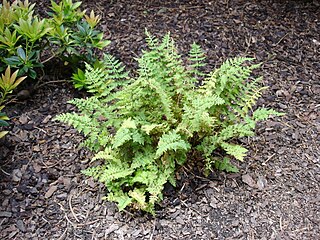
Cystopteris dickieana, commonly known as Dickie's bladder-fern, is a fern with a wide distribution in the Northern Hemisphere. There is debate amongst botanists as to whether it is a species in its own right or a variant of C. fragilis.

Cystopteris fragilis is a species of fern known by the common names brittle bladder-fern and common fragile fern. It can be found worldwide, generally in shady, moist areas. The leaves are up to 30 or 40 centimeters long and are borne on fleshy petioles with few or no long hairs. Each leaf is divided into many pairs of leaflets, each of which is subdivided into lobed segments. The underside of the leaf has many rounded sori containing the sporangia.
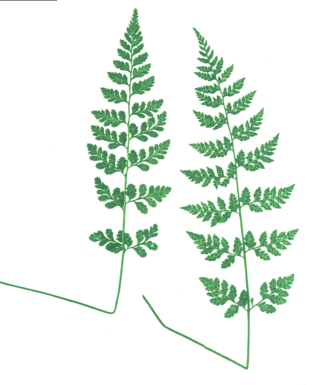
Cystopteris protrusa is a common fern of North America, commonly known as the lowland bladderfern, lowland brittle fern or lowland fragile fern.

Cystopteris bulbifera, with the common name bulblet fern, bulblet bladderfern, or bulblet fragile fern is a fern in the family Cystopteridaceae.
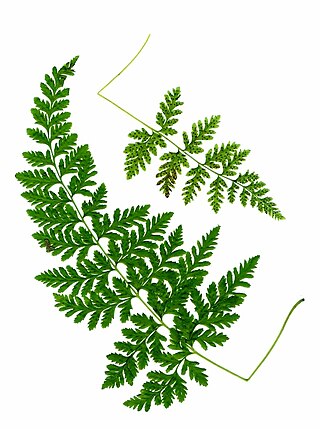
Cystopteris tenuis is sometimes known as Mackay's bladder fern or Mackay's fragile fern. It was long considered to be a part of the superspecies for fragile ferns, as Cystopteris fragilis(L.) Bernh. var. mackayiLawson.

Cystopteridaceae is a family of ferns in the order Polypodiales. In the Pteridophyte Phylogeny Group classification of 2016 (PPG I), the family is placed in the suborder Aspleniineae of the order Polypodiales, and includes three genera. Alternatively, it may be treated as the subfamily Cystopteridoideae of a very broadly defined family Aspleniaceae.
C. fragilis may refer to:
James Clair Parks, Ph.D. (1942–2002) was an American botanist and plant taxonomist who was a professor and herbarium curator at Millersville University in Millersville, Pennsylvania, USA from 1967 until his death in 2002. In 2004, the herbarium at Millersville University was dedicated in his honor as the James C. Parks Herbarium.

Cystopteris alpina is a fern in the family Cystopteridaceae. It is closely related to C. fragilis and has been treated as conspecific with that species by many authors. However, according to the Flora of North America, it is an allopolyploid species of hybrid origin, with Cystopteris montana as one probable parent. It is known to hybridise with C. fragilis in Scandinavia and intermediate plants possibly of hybrid origin are known from North Wales.
Erythranthe hymenophylla, synonym Mimulus hymenophyllus, is a species of flowering plant in the lopseed family known by the common names thinsepal monkeyflower and membrane-leaf monkeyflower. It is native to Hells Canyon on the border between Oregon and Idaho in the United States. It has also been reported from Montana.

Cystopteris montana, previously classified as Athyrium montanum, is a species of fern known by the common name mountain bladderfern. It occurs throughout the high latitudes of the Northern Hemisphere, in Eurasia, Greenland, and Alaska, and throughout Canada. It is also present in the higher elevations in Colorado farther south.
Puccinellia laurentiana is a perennial grass which grows on gravelly seashores in south-eastern Canada. Its specific epithet "laurentiana" refers to the Gulf of St. Lawrence, where it grows.
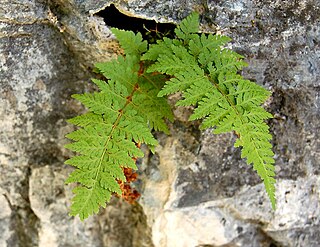
Cystopteris utahensis, commonly called the Utah bladderfern is a rare species of fern found in canyons and on sheltered cliff faces with calcareous rocks. It mainly grows on the Colorado plateau in the western United States, but is also found in a few locations in southern New Mexico and an adjacent area of Texas. Studies of its genetics show that it originates from a natural hybrid of the species Cystopteris bulbifera and Cystopteris reevesiana.
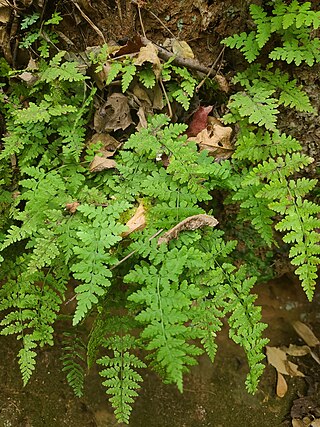
Cystopteris tennesseensis, commonly known as the Tennessee fragile fern or Tennessee bladderfern, is a species of fern in the family Cystopteridaceae.













